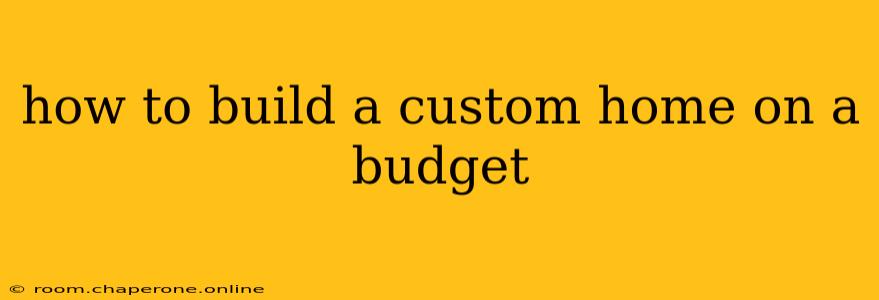Building your dream home is exciting, but the costs can quickly spiral out of control. Many believe that custom homes are synonymous with exorbitant prices, but with careful planning and strategic decisions, you can build a beautiful, personalized home without breaking the bank. This comprehensive guide outlines key strategies to build a custom home on a budget, focusing on practical advice and actionable steps.
1. Pre-Construction Planning: Laying the Foundation for Budgetary Success
Before you even think about blueprints, thorough planning is crucial. This phase determines the success of your budget.
1.1 Define Your "Must-Haves" and "Nice-to-Haves":
Creating a prioritized list is essential. What features are non-negotiable? What can be sacrificed or postponed? This clarity prevents feature creep, a major budget buster. For example, a large, open-plan kitchen might be a "must-have," while a finished basement could be a "nice-to-have" for later.
1.2 Realistic Budget Determination:
Don't underestimate costs! Consult with multiple builders to get accurate estimates. Factor in contingency funds (at least 10-15% of your total budget) for unexpected expenses. Explore different financing options, such as construction loans, to understand interest rates and repayment schedules.
1.3 Land Selection: A Significant Factor:
The cost of land significantly impacts your overall budget. Consider less desirable locations or smaller lots to reduce land expenses. Look beyond the immediate appeal; investigate potential property taxes, utility costs, and future development plans in the area.
1.4 Choose a Simple Design:
Complex architectural designs increase construction time and costs. Opt for a straightforward, efficient floor plan that minimizes waste and maximizes space. Avoid unusual angles or excessive detailing, focusing on functionality and clean lines.
2. Construction Phase: Smart Choices for Cost Savings
During construction, many opportunities exist to save money without compromising quality.
2.1 Select the Right Builder:
Research thoroughly and get multiple bids. Compare not just the price but also the builder's reputation, experience, and communication style. Look for builders with a proven track record of completing projects on time and within budget.
2.2 Prioritize Value Engineering:
This involves finding cost-effective alternatives without sacrificing quality. For instance, using less expensive materials in less visible areas or choosing energy-efficient appliances can significantly reduce costs.
2.3 DIY Where Possible:
Consider tackling some tasks yourself, such as painting, landscaping, or flooring installation. This can save significant labor costs, but only undertake DIY projects within your skillset.
2.4 Material Selection:
Choose cost-effective but durable materials. Explore alternatives to high-end finishes; often, less expensive options offer comparable functionality and aesthetics. Consider using reclaimed or recycled materials for an eco-friendly and budget-conscious approach.
2.5 Streamline the Process:
Effective communication with your builder and subcontractors is critical. Establish clear timelines and expectations to avoid delays and cost overruns.
3. Post-Construction: Finalizing Your Dream Home
Even after construction, opportunities remain to manage expenses.
3.1 Landscaping on a Budget:
Prioritize functionality over elaborate design. Use native plants that require less maintenance and water. Consider DIY landscaping solutions or phased planting.
Conclusion: Building Your Dream Home Within Your Means
Building a custom home on a budget requires meticulous planning, smart decision-making, and a willingness to prioritize. By following these strategies, you can create a personalized home that reflects your style and needs without compromising your financial stability. Remember, the key lies in balance: finding the sweet spot between your dream home and your budget. With careful consideration and proactive planning, building your dream home can be a rewarding and financially responsible experience.

